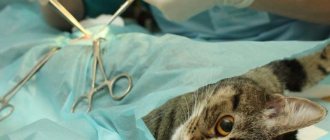Performing the procedure to remove reproductive organs in cats is not particularly difficult for a specialist. In order to minimize the risks of possible complications and pathological conditions in the animal after surgery, it is necessary to properly prepare the cat for sterilization. The main points that the pet owner must carry out independently are timely vaccination and antiparasitic treatment (destruction of ectoparasites and worms). It is also important to keep the animal on a fasting diet for at least 12 hours before surgery.
Preparing a cat for sterilization
Preparing a cat for sterilization is an important point that requires attention from the owner and veterinarian. Before performing surgery to remove reproductive organs, the veterinarian must ensure the health of the animal. Sterilization is an abdominal operation and carries some risks. The intervention is performed under general anesthesia, which entails a certain anesthetic risk.
When the body's strength is weakened, there is a high probability of complications occurring during the animal's recovery period. Timely diagnosis of problems will help to delay surgical intervention until complete recovery occurs. If the animal has chronic diseases that are not a contraindication to sterilization, then the operation is performed, but the surgeon and anesthesiologist performing it will have to take into account the specifics in order to reduce the risk of complications. Preparation for sterilization using the laparoscopic method is no different, since when performing an operation using this technique, general anesthesia is also administered.
Sterilization: is it worth it?
Many cat owners do not understand exactly what spaying or neutering a cat is. In the first case, an operation is performed during which the gonads are ligated. Castration involves the removal of glands in both male and female cats. During sterilization, the female's ovaries are removed, and the male's seminal canals are ligated. In case of castration, everything is removed.
If the owner prefers that the animal is purely domestic, does not ask to go outside and does not leave marks around the house, then it can be castrated. Your veterinarian can tell you how cats are sterilized and which method is best to use.
This procedure has many advantages, which are as follows:
- an animal that has undergone castration surgery lives longer;
- the pet is less susceptible to genitourinary diseases, oncology and all kinds of infectious diseases;
- cats may experience tumors of the mammary glands and inflammation of the ovaries;
- there is a normalization of metabolic processes and cats require less food, contrary to popular belief that after sterilization they gain weight.
Today, there are a lot of drugs that suppress desire and instantly relieve the animal of desire. But such drugs carry dangers. Against the background of their action, acute inflammation may occur, which will require urgent surgical intervention.
Sterilization methods
We invite you to familiarize yourself with how cats are sterilized and what methods are used to solve this problem. A good qualified specialist will help you decide on the optimal sterilization method.
| Name | The essence |
| Ovariectomy | Spaying |
| Ovariohysterectomy | Removal of the uterus and ovaries |
| Dressing | Tubal ligation |
| Hysterectomy | Removal of the uterus while preserving the ovaries |
| Laparoscopic sterilization of cats | The most humane method, in which a minimal incision is made and the ovaries are removed using instruments. |
| Chemical reversible sterilization | For those who wish to sterilize purebred animals for some period, but with the possibility of a reversible process, this type of sterilization is prescribed. It uses a Suprelorin chip. |
What the owner needs to do
First of all, the owner of the animal must carry out anthelmintic treatment of the pet before surgery. It is recommended to deworm every 3 months. Antiparasitic treatment includes not only getting rid of worms, but also lice, fleas and ticks. Before carrying out surgical manipulation, it is advisable to do treatment for worms 10-14 days in advance. It is important to note that if deworming was carried out less than one month ago, then it is not necessary to re-give the anthelmintic drug. The veterinarian who will carry out the sterilization must select the type and dosage of the drug.
An important aspect when preparing for surgery is timely vaccination. All pets must be vaccinated, regardless of whether the owner plans to sterilize or not. Carrying out abdominal surgery, which is ovariohysterectomy, in the absence of vaccinations, is associated with a high risk of infection. At least 30 calendar days must pass from the last vaccination before the animal can be operated on.
Sometimes owners refuse to vaccinate their pets. In this case, veterinary specialists at the clinic offer an injection of a special serum that allows you to develop a lasting immune response lasting 2 weeks against various infectious diseases.
The last point that the owner must fulfill is to keep the animal on a forced diet. A fasting diet involves complete food restriction for a period of 10 to 12 hours. During this period, the animal should not be given food, but water can be given. This preparation is carried out in order to minimize the risks of aspiration pneumonia in the animal after sterilization. While anesthesia is in effect, your pet may vomit. If there is food in the stomach, vomiting may cause particles to enter the respiratory system.
What should you not do the day before? Basic Rules
Preparing the cat for surgery begins 24 hours in advance. The veterinarian will tell you in detail what and how to do at this time. The main recommendations of doctors will be:
- Trim the claws to prevent the cat from injuring itself after surgery.
- Adhere to a proper diet.
- Avoid stress.
Is it possible to feed? In no case!
We stop feeding at least 12 hours before surgery. This is necessary so that the animal does not vomit while under anesthesia and when emerging from it.
What about drinking water?
Drinking water is not allowed 5 hours before surgery. It is imperative to ensure that the cat does not have access to water during this time.
What does the veterinarian check before sterilization?
Before sterilization, a veterinarian must perform an examination, including measurements of body temperature, body weight, respiration and pulse. It is also necessary to conduct a general blood test and biochemistry for the animal. This allows for timely detection of possible pathological conditions of the body that do not manifest characteristic symptoms. A biochemical blood test will allow you to assess the state of the immune system, identify inflammatory processes and other abnormalities.
Echocardiography is also important, especially if the animal is elderly, and also if it has a history of chronic diseases. Ultrasound examinations of the liver and kidneys are prescribed to check for violations of their functional characteristics. In addition to an ultrasound examination of the heart, the veterinarian may prescribe additional diagnostics in cases where the animal was street and brought to the clinic. In such cases, it is necessary not only to diagnose internal systemic diseases, but also to identify infectious diseases - panleukopenia, leukemia virus and immunodeficiency.
Examinations by a veterinarian are carried out 2-5 days before planned sterilization. The owner of the animal must take the preparation before sterilization with the utmost responsibility. This will reduce the risk of postoperative complications and other negative consequences.
Pros and cons of a sterilized cat
An adult unsterilized cat, deprived of mating with a male cat, often develops health problems, which leads to her short life. The decision to sterilize a pet will please owners with a number of positive aspects and reduce the risks of inflammatory diseases of the reproductive organs. Advantages of the operation:
- life expectancy will increase;
- good health will be maintained;
- the cat will stop bothering the owner with instincts that regularly wake up in the spring;
- lack of offspring that need to be accommodated;
- the cat stops marking its territory, emitting unpleasant odors.
In addition to the positive aspects, it is worth mentioning the disadvantages of the procedure:
- the appearance of seams on the animal’s body;
- the cat requires special care after surgery;
- increased appetite may arise;
- in rare cases, a hernia may develop.
© shutterstock
When is the best time to spay a cat?
Veterinarians are mostly unanimous in their opinion on what age a cat should be spayed and what physical condition is suitable for surgery.
Optimal age
Veterinarians call the optimal time to sterilize a cat between 7 and 8 months. At this age, all organs are fully formed and ready to perform reproductive functions. In some pets, maturation occurs earlier or slightly later than this age - due to anatomical or breed characteristics. Therefore, in order to individually determine at what age a cat is sterilized, it is necessary to regularly show it to the doctor and conduct an examination. Intervention in the body of an elderly or too young individual can lead to serious complications and chronic health problems.
Is it possible to have surgery during estrus?
During the period of manifestation of sexual instincts, the procedure is carried out in case of urgent need, but awakening from anesthesia and healing of sutures after sterilization of a cat is much more difficult during estrus than without it. Experts advise performing surgery two weeks before or two weeks after estrus. But sometimes it happens that estrus lasts a long time, with breaks of 1 to 5 days. Then it is impossible to maintain the required two-week period. In this case, the removal must be carried out unscheduled to avoid excessive exhaustion of the female.
Sterilizing a cat during pregnancy
The procedure during pregnancy is called hysterectomy. It is carried out for urgent medical reasons aimed at saving the life of the expectant mother. It is not recommended to spay a healthy pregnant cat. This is explained by the fact that during gestation, the pet’s body experiences strong changes at the level of hormone production and physiology in general. Therefore, there is a high probability of high blood loss, plus recovery after surgery will be longer. A minor, but still a minus - the seam will be very large in size.
Surgery after childbirth
Surgical intervention after pregnancy and childbirth will not relieve the pet from periodic manifestations of the sexual instinct to attract a male. The female hormone estrogen has already begun to be produced, as well as other secretions. Therefore, characteristic behavior can persist for a long time. Removing the reproductive organs will help prevent pregnancy in this case, but will not stop the cat's night cries - at least not immediately. The operation after childbirth must be carried out taking into account certain rules:
- If the mother does not feed the kittens, then you need to wait 1 month.
- If the pet is nursing, then wait 2-3 months after birth.
The optimal time for carrying out the procedure after lambing is considered to be 60 days. During this time, the hormonal levels return to normal, the uterus returns to its normal size, and the circulatory system in the pelvis is restored.
Surgery
Introductory anesthesia
Before the start of the operation, premedication is carried out - the installation of intravenous catheters, the administration of medications. The animal is put into anesthesia sleep. Next, the surgical field is prepared: the hair is shaved in a sufficient volume to avoid it getting into the surgical incision; treat the skin area with detergents and disinfect.
Deep anesthesia
The patient is admitted to the operating room, where he is given deeper anesthesia, if necessary, the trachea is intubated and connected to gas anesthesia. To do this, doctors use an anesthesia station with oxygen and gas - isoflurane, which maintains a state of sleep.
Sensors are connected to the animal for the purpose of monitoring for the entire time it is under anesthesia. Next, the anesthesiologist selects the type of anesthesia depending on the type of operation. For example, this could be: regional conduction anesthesia (epidural, nerve plexus block, etc.), local local anesthesia or general deep surgical anesthesia.
At this time, the surgeon's assistant completes the preparation of the surgical field. Once the anesthesiologist is completely sure that the patient is sufficiently anesthetized and is in the required stage of sleep, he gives the command to the surgeon to begin the operation.
Operation
This is the period during which the necessary surgery (or procedure under sedation) is performed. The doctors work harmoniously: the surgeon and his assistant carry out the necessary surgical procedures, and the anesthesiologist monitors the animal’s vital signs. Monitoring of heart rate, blood pressure (tonometry), respiratory rate (possibly connecting a ventilator), oxygen saturation of the body, the amount of carbon dioxide in the exhaled air mixture, temperature, and ECG monitoring.
At what age are cats spayed?
The ideal age for sterilization in cats is a relative concept. The operation can be performed at almost any age; from 6 months to 10 years it is tolerated quite easily. Older individuals may have contraindications or complications. Today, many veterinarians recommend carrying out the procedure up to a year or after the first heat. At a young age, the animal tolerates all manipulations easily and quickly adapts to the new state. He has not yet formed stable habits, which can be stronger than hormones. For example, an adult that is accustomed to marking its territory will likely continue to do so after spaying or neutering. Therefore, it is wise to act on warning and form the pet’s character and habits from a young age. It is believed that by 8 months a cat reaches sexual maturity and can bear and bear offspring up to 4 times a year. But, firstly, this is individual, for some individuals this moment comes earlier, for others later, and secondly, there are breeds in which the offspring grow for a long time and mature only by one and a half to two years. It is too early to sterilize such cats at 8 months, and it is better to select the timing of the operation together with a veterinarian. In general, the bulk of procedures occur between the ages of one and three years.
Day of surgery: what to do
Once again, do not stress the cat on the day of surgery. You should arrive at the clinic not a couple of minutes before your appointment, but about 40 minutes or at least half an hour. At this time, the owner can talk to the pet, stroke and calm it down.
Of course, you shouldn’t show up a couple of hours before, either, since the cat will only become more nervous during a long wait.
Possibility of complications
Despite the simplicity of the surgical intervention, removal of reproductive organs can lead to certain complications. For example, a neutered cat will often develop a lump in the abdominal area. It occurs due to swelling of the soft tissues, as well as the division of new cells that are necessary to heal the wound. Such a lump in a cat after sterilization is not considered dangerous and will resolve over time. But if the neoplasm appears as a hernia in the internal tissues after the cat is sterilized through a suture, then emergency surgery will be needed. Other possible complications include:
- allergies to drugs;
- deterioration of kidney or liver function after anesthesia;
- cardiovascular dysfunction;
- bleeding.
The development of such complications may depend both on the quality of the operation and on its method. This is also affected by age, health status at the time of the intervention and postoperative care of the sterilized cat.
Surgical intervention in the female body is aimed at preventing reproductive functions. There are different types and methods of performing the procedure. Before the operation, examinations, tests, and examination of the patient are prescribed. In case of proper postoperative care, the pet does not experience complications, and its character, behavior and health improve significantly.
The article is for informational purposes only. Contact your veterinarian!
Do you like the article? 177
Tests and vaccinations before sterilization
It doesn’t matter whether you take your cat for sterilization or not, vaccination is always necessary. Regardless of the conditions for sterilizing a cat, if vaccination has not been carried out, the animal runs the risk of contracting many dangerous infections that can greatly weaken it. To prevent this from happening, you need to take care of vaccinating your pet at a young age.
But it happens that the owners skipped this stage and learned about the need for vaccination immediately at the time of preparing the cat for the sterilization operation. In this case, you need to immediately vaccinate the cat, and postpone the operation for a month - at least 30 days must pass between vaccinations.
If you do not want to vaccinate your cat under any pretext, your veterinarian will advise you to give it an injection that will develop immunity for 14 days. This precaution significantly increases the cost of the operation, but allows you not to be afraid of infection of your pet when the immune system is weakened after the operation.











